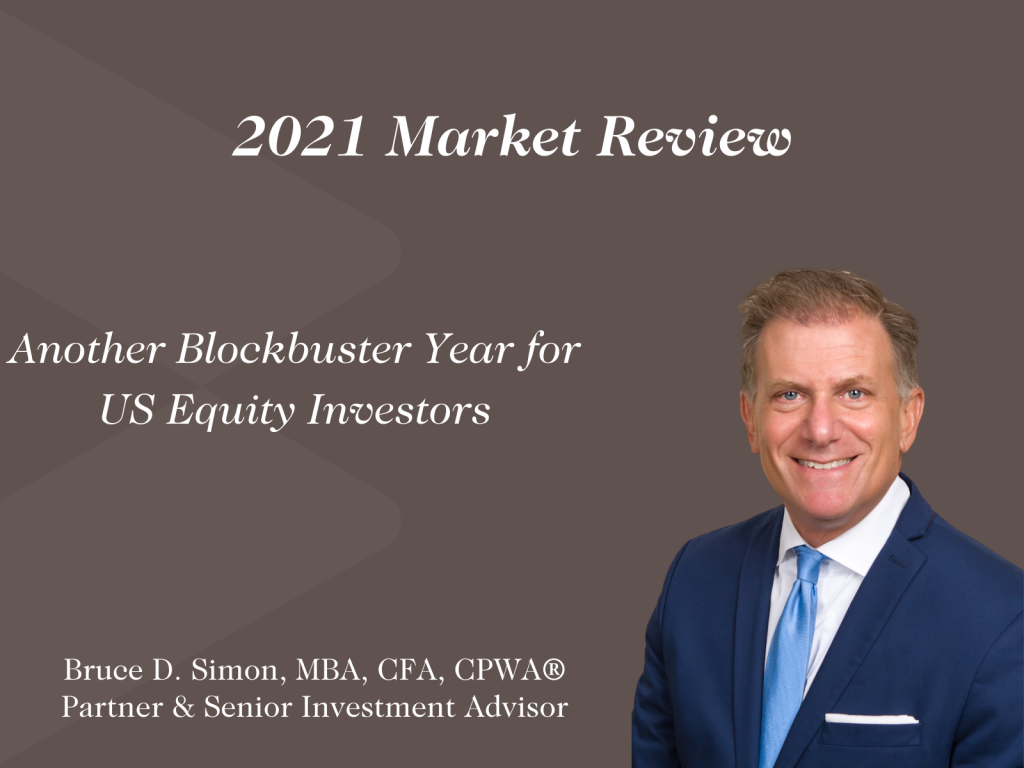Market Recap
Powered by a huge boost in corporate earnings and highly stimulative monetary and fiscal policies, the S&P 500 Index of large US stocks bolted higher by 29% in 2021, capping a spectacular period that saw the bellwether US stock index double in the last three years. During this volatile period, investors were undeterred by a contentious US presidential election, a cataclysmic decline in the global economy, a sharp rise in inflation, and more than 5 million deaths globally as a result of the COVID-19 pandemic.
Ignoring a sharp valuation discount between the United States and international equities, US investors opted for the comfort of their home market. In 2021, the Russell 3000 Index of US equities gained 25.7%, dwarfing the return of the MSCI EAFE International Index of 11.3%. The strength in US stocks came largely from the biggest companies; small and mid-cap stocks generated only about half the return of their larger brethren last year.
Long-suffering holders of emerging market equities found no solace in the MSCI Emerging Market Index’s decline of -2.5% in 2021. Along with a threatened default of a large Chinese real estate developer, the Chinese Communist party’s increasingly authoritarian regulatory actions against private industry led to sharp declines in many Chinese stocks.
Many of the small-cap, high growth stocks that soared in 2020 (e.g., Peloton, Zoom Video) came crashing to earth as investors rotated to cyclical stocks that would benefit from a strong economic recovery. Higher interest rates also were a drag on these companies, as in many cases their valuations are supported by discounting fast earnings growth far into the future.
Perhaps most surprising about the performance of major asset classes in 2021 was the bond market’s seeming indifference to the sharp rise in inflation during the year. Although the bellwether 10-year note yield rose from an historic low of 0.91% at the start of the year to 1.51% by year-end, that level was not adequate to offset a 6% rise in consumer prices experienced during the year. The low yields can be explained in part by the Federal Reserve’s aggressive intervention in the bond markets, keeping prices high (and yields low) by acquiring approximately $120 billion of bonds each month.
Reflecting the gathering strength in the global economy, commodities staged a robust rally afteryears of disappointing performance. Oil prices surged 60% during the year and industrial metals surged, reflecting increased demand and tight supplies. Low interest rates and recovering demand led to sharp gains in real estate investment trusts and residential housing prices.
Outlook and Strategy
As we entered 2021, Ballentine Partners expected another strong performance in equity prices as the economy recovery accelerated and liquidity (through the efforts of central banks and supportive government policies) was plentiful. Our main concern was about equity market valuations, having enjoyed a spectacular recovery from the March 2020 lows coming on top of the strong performance of the stock market in 2019.
For equities to move higher in 2022, it will most likely have to occur without the tailwinds of liberal fiscal and monetary support. Faced with uncomfortably high inflation that has defied the term “transitory”, the Federal Reserve will be moving to contain this threat by eliminating its open market bond purchases in the next few months and then ratcheting up the federal funds rate. Consensus expectations call for as many as three rate hikes in 2022, followed by several more in 2023. Even the specter of depressed economic activity caused by a resurgent COVID-19 outbreak is unlikely to deter the Fed from this mission given the possibility that, left unchecked, inflation could once again become a systemic economic problem. At the same time, partisan gridlock in Washington is likely to prevent any more fiscal stimulus that could boost the economy in the short term.
We expect that a combination of the Fed’s efforts and improving supply chain conditions will lead to inflation declining by the second half of 2022 but remaining above the Fed’s target of 2% for some time to come. As the Fed tightens monetary policy, interest rates should rise, raising the cost of debt and generally slowing the pace of economic growth.
Nonetheless, barring a major retrenchment from new COVID-19 restrictions, we expect US real GDP growth in 2022 will approximate 4%, well above historical averages. Corporate profits should rise as well, but more in line with traditional growth rates of 6-8%. With uncertainty high, we anticipate a volatile year in equity prices but expect modest positive returns for investors. We remain cautious on traditional fixed income with after-inflation returns expected to be negative for another year. Selected nontraditional strategies that offer generous yields (e.g., private credit, leasing, and royalty arrangements) continue to look attractive in our view.
Should inflation remain persistently high, equities and real assets (real estate, natural resources, and infrastructure) are likely to offer the best possibilities for appreciation in both public and private markets. Partnering with premier managers in private equity, venture capital, private real estate, and impact/ESG-focused managers will be a major focus for our investment teams in 2022.
We wish everyone a safe, happy, and successful year ahead.
About Bruce D. Simon, CFA, CPWA®
Bruce is a Partner and the Director of Research at the firm. In addition to working directly with a number of family clients, Bruce serves on Ballentine’s Investment Management Committee, which is responsible for the oversight of all of the investment activities for the firm.
This report is the confidential work product of Ballentine Partners. Unauthorized distribution of this material is strictly prohibited. The information in this report is deemed to be reliable but has not been independently verified. Some of the conclusions in this report are intended to be generalizations. The specific circumstances of an individual’s situation may require advice that is different from that reflected in this report. Furthermore, the advice reflected in this report is based on our opinion, and our opinion may change as new information becomes available. Nothing in this presentation should be construed as an offer to sell or a solicitation of an offer to buy any securities. You should read the prospectus or offering memo before making any investment. You are solely responsible for any decision to invest in a private offering. The investment recommendations contained in this document may not prove to be profitable, and the actual performance of any investment may not be as favorable as the expectations that are expressed in this document. There is no guarantee that the past performance of any investment will continue in the future.




